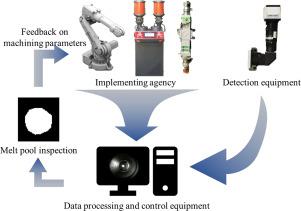基于时间自适应模块的改进U-net网络用于lcd增材制造中熔池的精确检测
IF 6.8
1区 工程技术
Q1 ENGINEERING, MANUFACTURING
引用次数: 0
摘要
熔融粉末激光定向能沉积(LDED)是一种用激光加热和熔化金属粉末的过程,然后使粉末凝结成基材上的熔池。这些水池的特点对组件的材料和物理质量有直接的影响。因此,准确及时地检测熔池形状对于有效的质量监测和反馈管理至关重要。为了在lcd增材制造过程中对金属熔池区域进行像素级划分,提出了一种基于时间自适应模块(TAM)的改进U-Net网络。首先,建立了熔池形貌数据库,其中包括各种加工因素和金属粉末成分。然后,建立了一种先进的U-Net网络,对熔池区域进行语义划分,以获取准确的熔池边界信息。对多个语义分割模型进行了对比研究,并通过一系列烧蚀实验验证了模型各组成部分的具体贡献。测试结果表明,改进后的U-Net模型准确率达到95.8%,FPS达到32.5 FPS,与其他网络架构相比,精度和性能都有了显著提高。最后,研究了熔池形态特征随各种加工因素的波动,以及熔池形态与激光功率、扫描速度、给粉速度的相互作用。本文章由计算机程序翻译,如有差异,请以英文原文为准。

Improved U-net network with temporal adaptive Module for precise melt pool detection in LDED additive manufacturing
Melt powder laser directed energy deposition (LDED) is a process that involves heating and melting metal powders with a laser, which then causes the powders to condense into molten pools on the substrate. The features of these pools have a direct impact on the components’ material and physical qualities. As a result, precise and timely detection of molten pool shape is critical for efficient quality monitoring and feedback management. In order to partition the metal molten pool region at the pixel level in LDED additive manufacturing process, an improved U-Net network based on the temporal adaptive module (TAM) is presented in this research. First, a database of melt pool morphology is created, which includes a variety of processing factors and metal powder components. Then, an advanced U-Net network is created to semantically partition the melt pool region in order to collect exact melt pool border information. A comparison study of multiple semantic segmentation models is also performed, and the specific contributions of each model component are confirmed via a series of ablation experiments. According to the testing results, the improved U-Net model achieves 95.8% accuracy and 32.5 FPS, which represents a significant improvement in accuracy and performance over other network architectures. Finally, the study investigated the fluctuation of melt pool morphological characteristics in response to various processing factors, as well as the interaction between melt pool morphology and laser power, scanning speed, and powder feeding rate.
求助全文
通过发布文献求助,成功后即可免费获取论文全文。
去求助
来源期刊

Journal of Manufacturing Processes
ENGINEERING, MANUFACTURING-
CiteScore
10.20
自引率
11.30%
发文量
833
审稿时长
50 days
期刊介绍:
The aim of the Journal of Manufacturing Processes (JMP) is to exchange current and future directions of manufacturing processes research, development and implementation, and to publish archival scholarly literature with a view to advancing state-of-the-art manufacturing processes and encouraging innovation for developing new and efficient processes. The journal will also publish from other research communities for rapid communication of innovative new concepts. Special-topic issues on emerging technologies and invited papers will also be published.
 求助内容:
求助内容: 应助结果提醒方式:
应助结果提醒方式:


